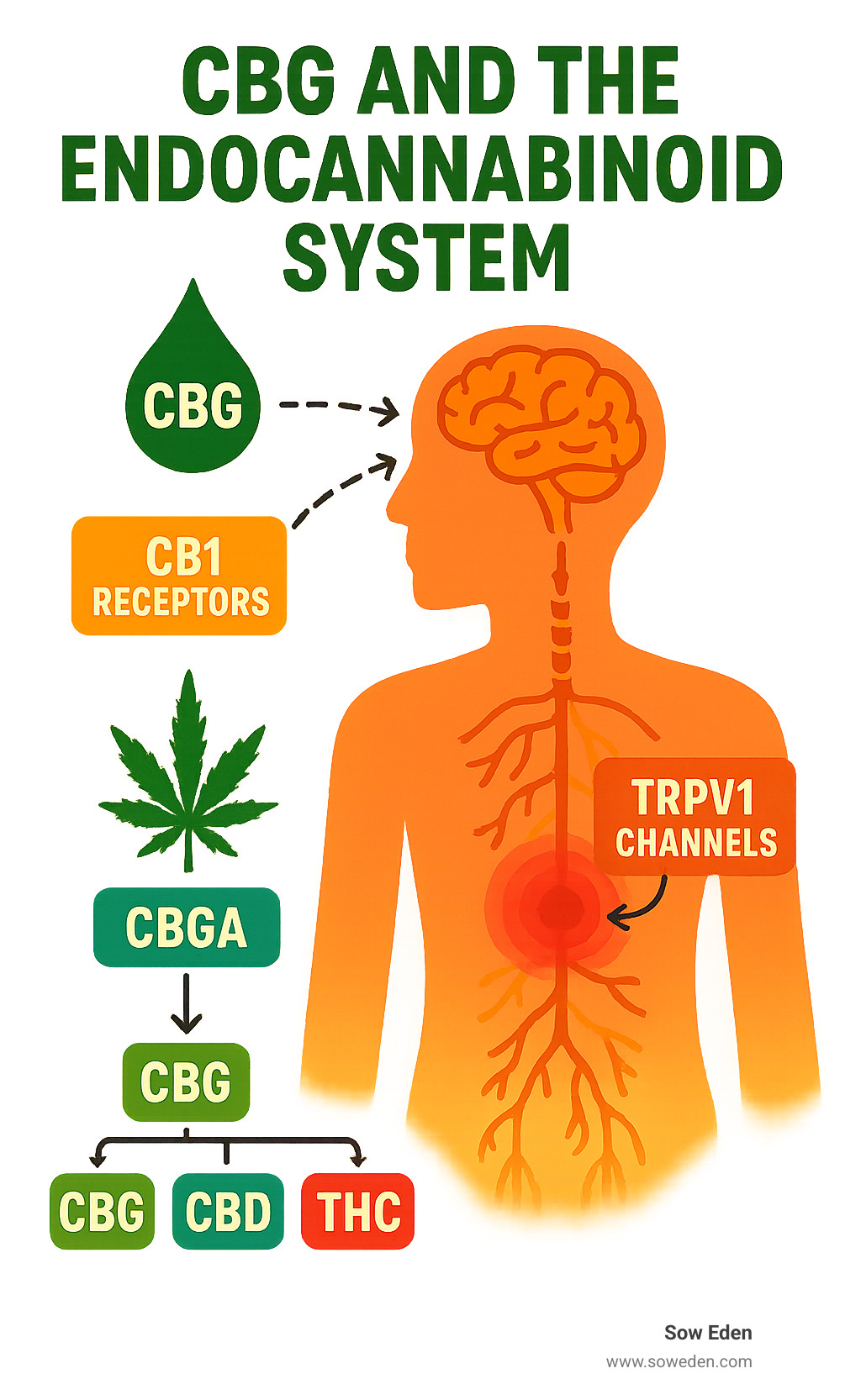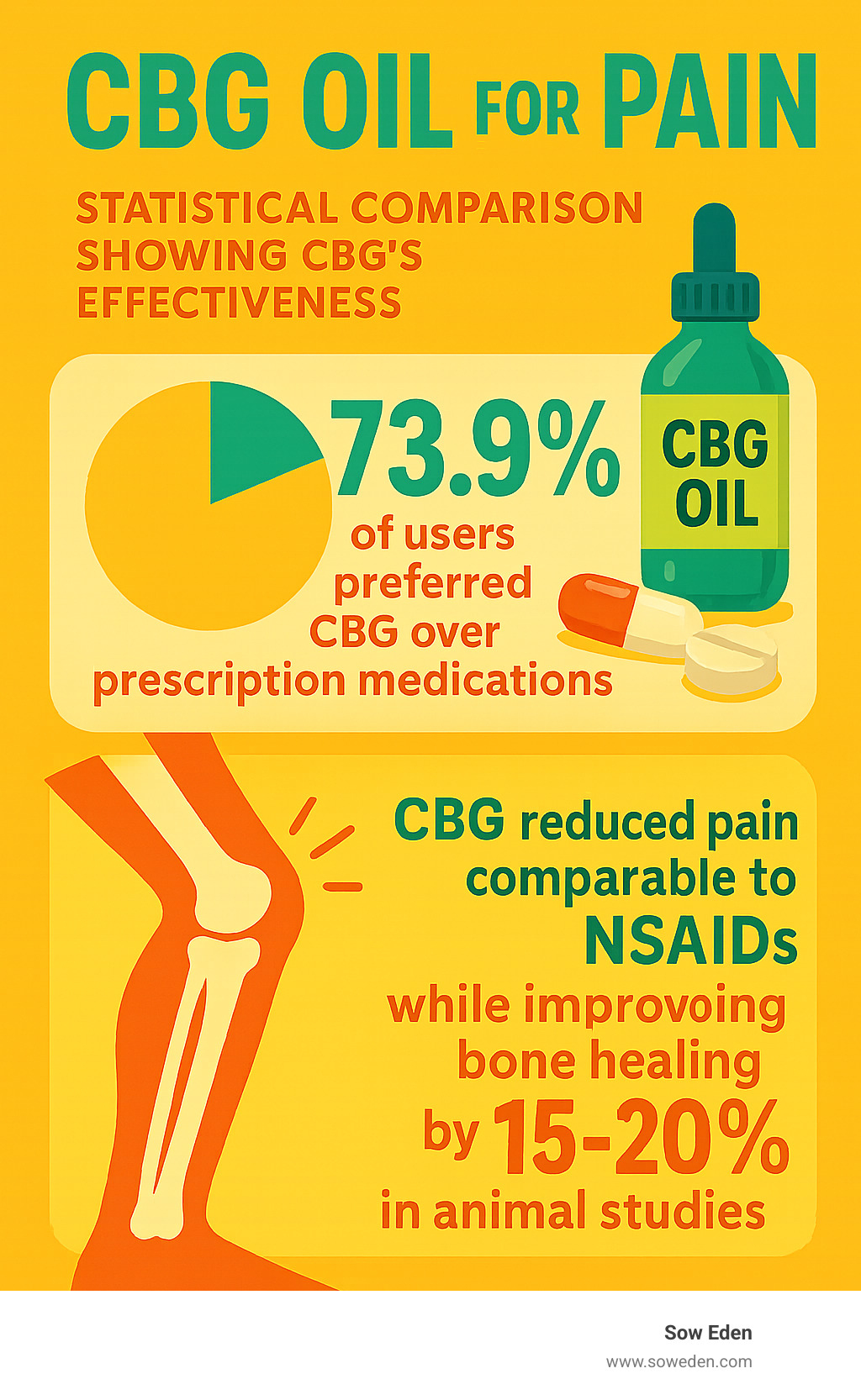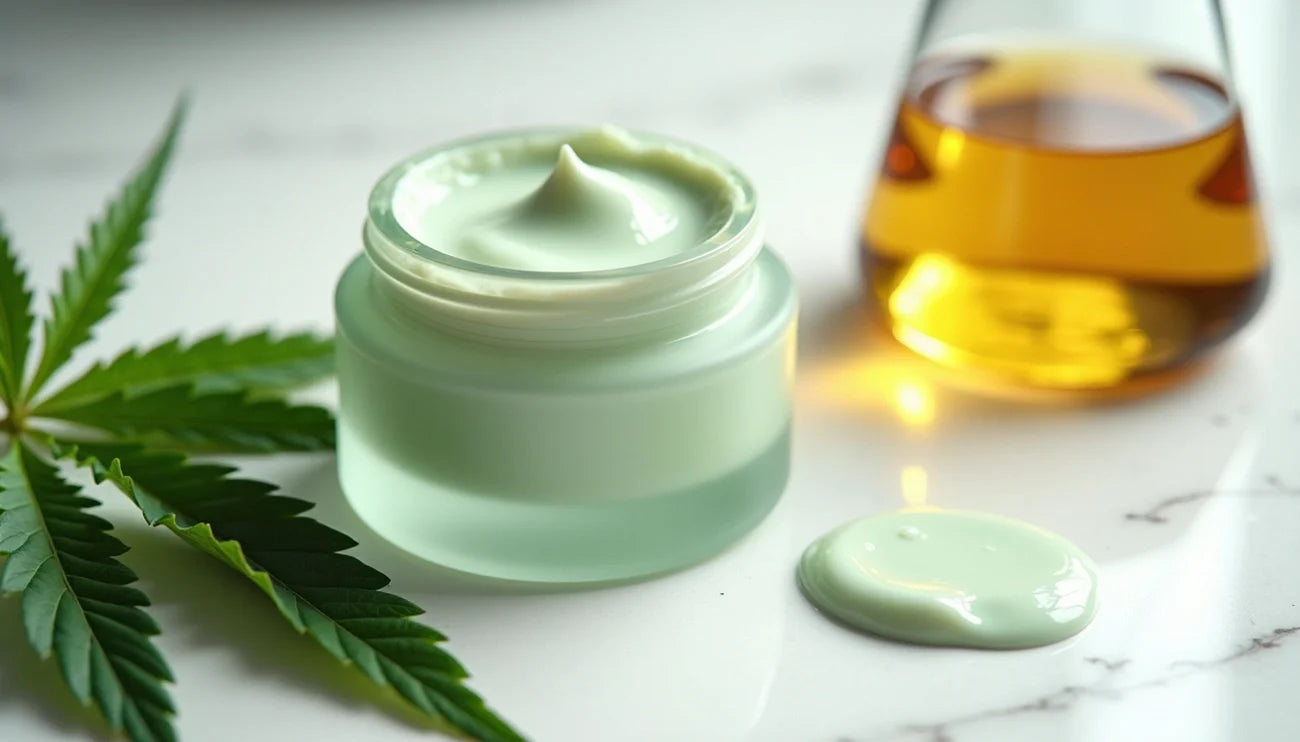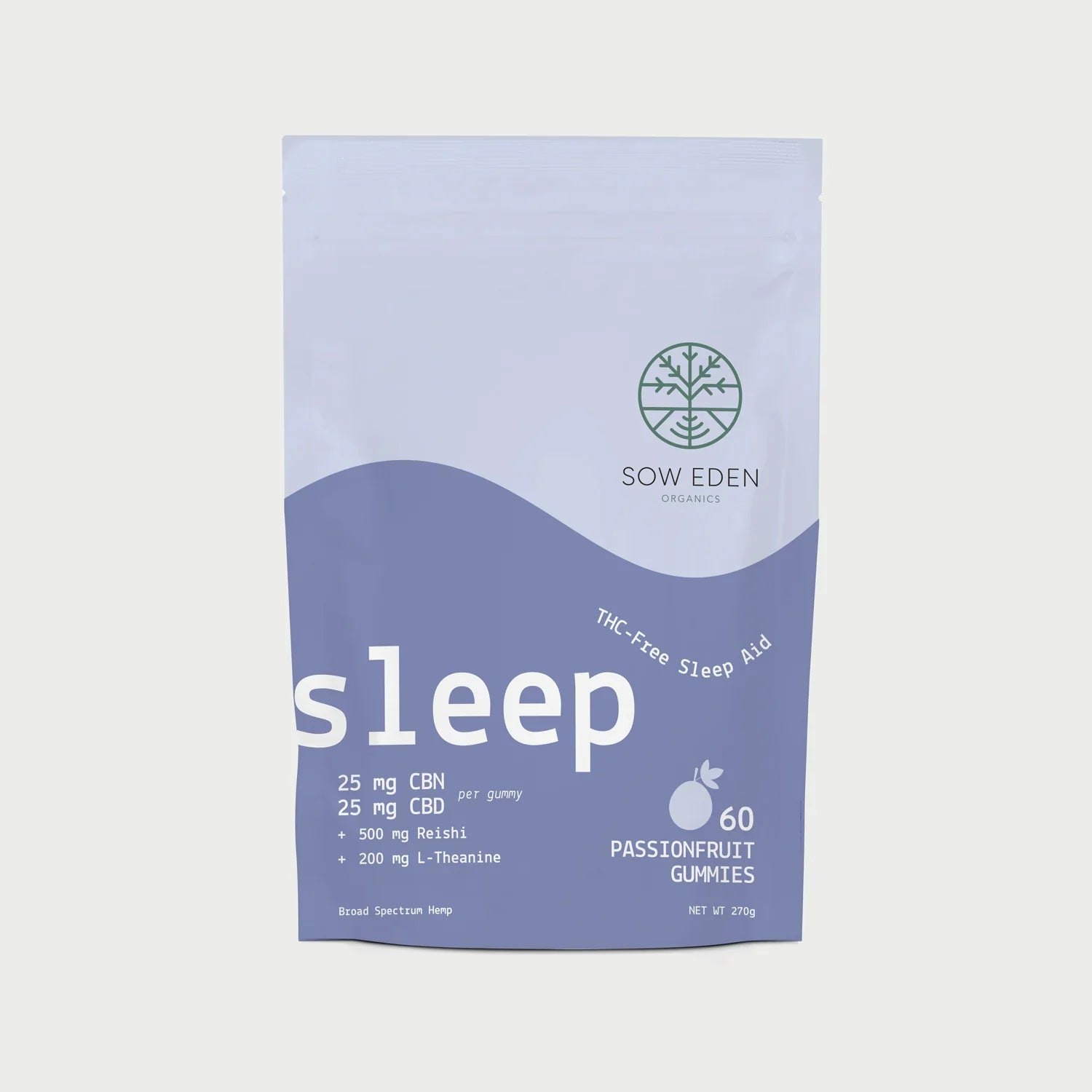Why CBG Oil for Pain is Gaining Scientific Attention
CBG oil for pain represents a promising frontier in natural pain management, offering relief without the psychoactive effects of THC. Here's what you need to know:
Quick Answer for CBG Oil for Pain: • What it is: Cannabigerol (CBG) extract that targets pain through multiple pathways • How it works: Binds to CB1/CB2 receptors and desensitizes pain signals via TRPV1 channels • Best for: Neuropathic pain, inflammation, bone injuries, and digestive discomfort • Effectiveness: Studies show CBG may outperform THC and aspirin for certain pain types • Safety: Non-psychoactive with minimal side effects when used properly
Pain affects hundreds of millions worldwide, driving the search for safer alternatives to traditional medications. CBG stands out as the "mother of cannabinoids" - the rare precursor that transforms into CBD and THC as hemp plants mature. This scarcity makes CBG more expensive to produce, but early research suggests it may be worth the investment.
Unlike its famous cousins, CBG offers pain relief without mental fog or intoxication. In a 2021 survey of 127 users, 73.9% reported CBG was superior to prescription medications for pain. Animal studies show CBG can reduce mechanical hypersensitivity from chemotherapy-induced nerve damage and may even accelerate bone healing while managing fracture pain.
The science centers on CBG's unique ability to work through multiple pain pathways simultaneously. It doesn't just mask symptoms - it appears to address underlying inflammation and nerve dysfunction that drive chronic discomfort.
I'm Jacob Dunn, CEO of Sow Eden Organics, where I've spent years developing premium broad-spectrum CBD formulations and studying how minor cannabinoids like CBG improve pain relief. My experience in holistic wellness has shown me that CBG oil for pain often provides relief where other natural options fall short.

Cbg oil for pain terms simplified: - cbg benefits - cbg for nerve pain
How Does CBG Oil for Pain Work in the Body?
Your body has an amazing built-in pain management system called the endocannabinoid system (ECS). Think of it as your personal security team, constantly monitoring for threats and trying to keep everything balanced. When you use CBG oil for pain, you're essentially giving this team some extra backup.
The magic happens when CBG connects with special receptors scattered throughout your body. CB1 receptors hang out mainly in your brain and spinal cord, acting like the control center for how you experience pain. When CBG binds to these receptors, it can dial down the intensity of pain signals before they fully register in your consciousness.
CB2 receptors work differently - they're your inflammation fighters, stationed primarily in immune cells and tissues throughout your body. When these receptors get activated by CBG, they help calm down the inflammatory processes that often fuel chronic pain conditions.
But here's where things get really interesting. CBG doesn't just work through the typical cannabinoid pathways. Research shows it can also desensitize TRPV1 receptors, which are like tiny alarm bells in your nervous system. When these receptors get overwhelmed, they send constant pain signals to your brain. CBG essentially helps turn down the volume on these alarms.
CBG also gives your body's natural "feel-good" chemicals a boost. It helps increase levels of anandamide, a molecule your body produces naturally to help manage pain and mood. By preventing this molecule from breaking down too quickly, CBG oil for pain essentially amplifies your body's own healing mechanisms.
The α2-adrenergic receptors add another layer to CBG's pain-fighting abilities. These receptors are involved in your body's stress response, and when CBG interacts with them, it can provide additional relief that goes beyond traditional pain pathways.
What makes CBG particularly exciting is the entourage effect - the way different compounds work together to create stronger results than they would alone. Scientific research on TRPV1 and cannabinoids shows how this teamwork approach can lead to more effective pain management.
Mechanisms at a Glance
CBG tackles pain through three main strategies that work together like a well-coordinated team.
Neurotransmitter modulation is CBG's way of fine-tuning your brain's chemical messengers. It influences how your nervous system processes pain signals and can even impact your mood. This explains why many people notice they feel better overall when using CBG oil for pain, not just physically but emotionally too.
Inflammation dampening happens when CBG activates those CB2 receptors we talked about earlier. Instead of letting inflammation run wild and create more pain, CBG helps your immune system respond more appropriately. This is especially helpful for conditions where inflammation creates a vicious cycle of discomfort.
Nerve signal blocking occurs through CBG's interaction with TRPV1 channels. Rather than letting every pain signal scream for attention, CBG helps your nervous system prioritize which messages really need to get through. It's like having a smart filter that reduces the noise while still letting important signals pass.
What the Research Says: Studies on CBG-Driven Pain Relief
The scientific community is taking notice of CBG oil for pain, and for good reason. Recent studies are painting an exciting picture of how this rare cannabinoid might change the way we approach pain management.
Let's start with one of the most compelling pieces of research. In 2022, scientists published findings in the European Journal of Pain that made waves in the cannabinoid research world. They studied mice with chemotherapy-induced peripheral neuropathy - a particularly nasty type of nerve pain that affects many cancer patients. When these mice received CBG at 10 mg/kg, something remarkable happened: their mechanical hypersensitivity dropped significantly.
What made this study even more interesting was how the researchers proved CBG was working. They confirmed that the pain relief came through both α2-adrenergic and CB1/CB2 receptor pathways. But here's the kicker - when they combined CBG with CBD, the results got even better. This wasn't just a lucky coincidence; it was solid evidence of the entourage effect in action.
The bone research might be even more exciting. Scientists at Penn State College of Medicine decided to pit CBG against traditional NSAIDs in mice with bone fractures. The Journal of Bone & Mineral Research findings revealed something that surprised even the researchers: CBG matched NSAIDs for pain relief while actually helping bones heal better.
This matters because NSAIDs have a dirty little secret. They knock out pain effectively, but they can actually slow down bone healing by interfering with the natural inflammation process that kicks off recovery. CBG seems to thread the needle perfectly - providing relief without sabotaging your body's repair mechanisms.
The real-world evidence backs up these laboratory findings beautifully. When researchers surveyed 127 people using CBG-predominant products, the results were striking: 73.9% reported that CBG was superior to prescription medications for pain. These weren't small improvements either. People described getting their lives back, returning to activities they'd given up on due to chronic discomfort.
For those dealing with nerve pain specifically, the research is particularly encouraging. Applications of Cannabinoids in Neuropathic Pain studies show that CBG's multi-receptor approach makes it especially effective for the complex pain conditions that often leave doctors scratching their heads. When you're dealing with both inflammatory and neuropathic components, CBG's broad-spectrum approach can be a game-changer.
Key Takeaways From Pre-clinical Trials
The animal studies reveal some fascinating patterns about how CBG oil for pain works in practice.
Mechanical hypersensitivity reduction appears consistently across multiple studies. This is huge for people who experience pain from things that shouldn't hurt - like light touch or gentle pressure. CBG seems to help reset that oversensitive alarm system that characterizes so many chronic pain conditions.
The CB1/CB2 pathway confirmation gives us confidence that we understand how CBG works. Researchers used receptor blockers to prove that CBG's pain-relieving effects really do depend on these cannabinoid receptors. It's not just wishful thinking - there's a clear biological mechanism at work.
Perhaps most importantly for anyone considering CBG oil for pain, the synergy with CBD keeps showing up in study after study. CBG works well on its own, but it consistently performs better when paired with CBD. This validates what many users have reported anecdotally and suggests that broad-spectrum formulations might be the way to go.

Which Pain Conditions Might Benefit From CBG Oil for Pain?
While research on CBG oil for pain is still emerging, early studies and user experiences point to several specific conditions where this rare cannabinoid might offer meaningful relief. Think of CBG as having a particular talent for complex pain situations where traditional approaches often fall short.
The most exciting findings center around nerve-related pain conditions. When your nerves are damaged or hypersensitive, they can send pain signals even when there's no actual tissue injury happening. This creates the burning, shooting, or electric-shock sensations that make neuropathic pain so challenging to treat.
Inflammatory conditions also appear to respond well to CBG's unique properties. Unlike pain medications that simply block signals, CBG seems to address the underlying inflammation that keeps pain cycles going. This makes it particularly interesting for conditions where inflammation drives ongoing discomfort.
Bone injuries represent an unexpected area of promise. Recent research suggests CBG oil for pain might not only help with fracture discomfort but actually support better healing outcomes - something traditional pain medications often can't claim.
Digestive pain conditions round out the list of potential applications. The gut contains numerous cannabinoid receptors, and early studies suggest CBG might help with both inflammatory bowel conditions and general stomach discomfort.
Headache sufferers also report benefits, though we need more research to understand optimal approaches for tension-type and other headache conditions.
Neuropathic Pain and CBG Oil for Pain
Nerve pain presents unique challenges because it often stems from damage to the nervous system itself rather than ongoing tissue injury. This explains why conditions like diabetic neuropathy or chemotherapy-induced nerve pain can persist long after the original cause is treated.
Chemotherapy-induced peripheral neuropathy (CIPN) affects many cancer survivors, creating persistent tingling, burning, or numbness in hands and feet. The 2022 animal study showing CBG's effectiveness for CIPN offers hope for this underserved population who often struggle with limited treatment options.
Diabetic neuropathy represents another area where CBG's multi-pathway approach might shine. High blood sugar damages nerves over time, creating pain that traditional medications often can't adequately address. CBG's ability to work through multiple receptor systems may provide more comprehensive relief.
The key seems to be CBG's unique ability to desensitize TRPV1 receptors while simultaneously supporting your body's natural pain-fighting mechanisms. This dual action addresses both the immediate discomfort and the underlying nerve hypersensitivity that keeps neuropathic pain going.
For more detailed information about specific protocols and user experiences, our guide on relieving nerve pain with CBG covers practical applications in greater depth.
Inflammatory & Arthritis Pain
Inflammatory pain creates a vicious cycle - tissue damage triggers inflammation, which causes more pain and potentially more damage. Breaking this cycle requires addressing the inflammation itself, not just masking the pain signals.
CBG oil for pain appears to work through CB2 receptors to help control inflammatory cytokines - the chemical messengers that coordinate your immune response. By promoting a more balanced inflammatory response, CBG may help reduce both pain and the tissue damage that perpetuates it.
Many users report improvements in joint stiffness alongside pain reduction. This suggests CBG affects the underlying inflammatory processes that limit mobility, not just pain perception. Morning stiffness often improves, and people find they can return to activities they'd previously avoided.
Inflammatory bowel disease research in mice shows promising results for CBG reducing colonic inflammation and associated discomfort. While we need human studies to confirm these effects, the findings suggest potential benefits for digestive conditions that cause both local and systemic inflammation.
The anti-inflammatory effects appear to be dose-dependent and work best when CBG is combined with other cannabinoids, supporting the entourage effect concept that whole-plant approaches often outperform isolated compounds.
Bone & Post-Injury Pain
The bone healing research represents one of the most exciting developments in CBG oil for pain applications. Traditional pain medications often create a difficult choice between comfort and optimal healing, since NSAIDs can actually slow bone repair.
CBG appears to offer the best of both worlds. The Penn State study found that fracture healing potential improved significantly with CBG treatment. Mice receiving CBG showed not only comparable pain relief to NSAID groups but also better healing outcomes overall.
The mineral density boost of 15-20% compared to NSAID treatment suggests CBG actively supports the bone rebuilding process while managing discomfort. This dual benefit could be particularly valuable for older adults or anyone at risk for delayed fracture healing.
Early treatment with CBG increased the number of bone progenitor cells available for repair, while later treatment accelerated mineral absorption into the healing bone. This suggests CBG oil for pain might be beneficial throughout the entire recovery process, not just for immediate post-injury comfort.

How to Use CBG Oil for Pain Safely and Effectively
Finding the right approach to CBG oil for pain can feel overwhelming at first, but with the right guidance, you'll find what works best for your unique situation. After years of helping people steer cannabinoid wellness, I've learned that success comes down to understanding your options and starting with a thoughtful plan.
The world of CBG oil for pain delivery methods offers something for everyone. Sublingual oils remain my top recommendation for most people dealing with pain. When you hold the oil under your tongue for 60-90 seconds, you're allowing CBG to absorb directly into your bloodstream through those thin tissues. This means you'll typically feel relief within 10-15 minutes, and you're getting the most bang for your buck with 20-30% bioavailability.
Gummies certainly have their place - they're convenient, taste great, and provide consistent dosing that some people prefer. However, the heat processing required to make gummies can break down some of those beneficial compounds we work so hard to preserve. Plus, they take 45-60 minutes to kick in and only offer 10-20% bioavailability since they have to go through your digestive system first.
Topical applications work beautifully for localized pain - think sore joints or muscle tension. You'll feel the effects within 5-10 minutes, but topicals don't provide the systemic relief that oils and gummies offer.
The start-low-go-slow approach isn't just a catchy phrase - it's your roadmap to success. Begin with 5-10mg of CBG and give your body a few days to adjust before increasing. Most people find their sweet spot somewhere between 25-50mg, though some need more depending on their pain severity and individual biochemistry.
Safety-wise, CBG oil for pain has an excellent track record. It won't get you high, won't show up on standard drug tests, and serious side effects are extremely rare. Hemp-derived CBG with less than 0.3% THC is legal in all 50 states thanks to the 2018 Farm Bill.
| Delivery Method | Onset Time | Bioavailability | Duration | Best For |
|---|---|---|---|---|
| Sublingual Oil | 10-15 min | 20-30% | 4-6 hours | Acute pain, precise dosing |
| Gummies | 45-60 min | 10-20% | 6-8 hours | Consistent daily use |
| Topicals | 5-10 min | Local only | 2-4 hours | Localized pain |
| Capsules | 30-45 min | 15-25% | 6-8 hours | Convenient daily dosing |
Finding Your Dose of CBG Oil for Pain
Finding your optimal CBG oil for pain dose is more art than science, but we can give you a solid starting framework. I often suggest people begin with a simple calculation: multiply your body weight in pounds by 0.3 to get your starting daily dose in milligrams. So if you weigh 150 pounds, you'd start with about 45mg per day.
That said, your body doesn't read formulas. Your metabolism, pain severity, previous experience with cannabinoids, and even your stress levels all influence how you'll respond. This is why the titration process becomes so important.
Keep things simple with your titration approach. Stick with your starting dose for 3-4 days, then bump it up by 5-10mg if you're not getting the relief you need. I always encourage people to keep a basic pain diary - just jot down your dose, timing, and how you felt throughout the day. You'd be surprised how helpful these notes become when you're trying to dial in your perfect protocol.
Timing matters more than you might think. CBG tends to be more energizing than its cousin CBD, so many people prefer taking their CBG oil for pain in the morning or early afternoon. However, if pain is keeping you awake at night, an evening dose might serve you better. Listen to your body and adjust accordingly.
For those who want to dive deeper into dosing strategies, our understanding CBG dosage guide covers specific protocols for different conditions and experience levels.
Pairing CBG With CBD for Improved Relief
Here's where things get really interesting - CBG oil for pain consistently works better when you combine it with CBD rather than using it alone. This isn't just marketing speak; it's backed by solid research showing that these cannabinoids create a synergistic effect that improves pain relief.
Most people start with a 1:1 blend of CBG to CBD, but don't feel locked into that ratio. Some folks find that 2:1 CBD to CBG works better for inflammatory conditions, while others prefer CBG-dominant formulations for nerve pain. Your optimal ratio might take some experimentation to find.
The entourage effect explains why this combination approach works so well. When cannabinoids team up with terpenes and other plant compounds, they amplify each other's benefits in ways that isolated compounds simply can't match. It's like having a full orchestra instead of a solo performance.
At Sow Eden, we've taken this concept even further by combining CBG-A and CBD-A (the acidic precursors) with natural botanicals like ginger root and lemon peel. These additions provide complementary anti-inflammatory support and help with absorption, creating a more complete wellness experience.
If you're curious about different cannabinoid combinations and how they compare, our CBG and CBD comparison guide breaks down the benefits of various approaches.
Safety, Side Effects & Drug Interactions
The safety profile of CBG oil for pain is one of its most appealing features. Most people tolerate it beautifully, with side effects typically being mild and temporary when they do occur.
Dry mouth tops the list of potential side effects, affecting about 10-15% of users. It's more of an annoyance than a serious concern - staying well-hydrated and keeping sugar-free gum handy usually does the trick.
Some people experience drowsiness, especially when starting out or using higher doses. If you need to stay sharp during the day, begin with smaller amounts and see how you respond. Always avoid driving until you know how CBG affects you personally.
The most important safety consideration involves enzyme interactions. CBG may influence certain liver enzymes that process many medications, potentially affecting how your body handles other drugs. This is particularly relevant if you take blood thinners, seizure medications, or any drugs with narrow therapeutic windows.
I always recommend that people consult their physician before adding CBG to their wellness routine, especially if they're taking prescription medications. Your doctor can help determine if CBG is appropriate for your situation and may suggest monitoring if you decide to move forward. It's always better to be safe and informed than sorry later.
Frequently Asked Questions about CBG Oil for Pain
People considering CBG oil for pain often have similar questions about how it compares to other options and what to expect. Let me address the most common concerns based on current research and user experiences.
Does CBG oil work faster than CBD?
CBG oil for pain does tend to work faster than CBD alone, particularly when you're dealing with sudden pain flares. Most people notice effects within 10-15 minutes when taking CBG sublingually, compared to the 20-30 minutes CBD typically takes to kick in.
This quicker onset likely happens because CBG interacts more directly with TRPV1 receptors - those pain signal pathways I mentioned earlier. CBG also seems to boost your natural anandamide levels more rapidly than CBD does.
But here's the thing - faster isn't always better for every situation. While CBG might give you quicker relief from acute pain, CBD often provides longer-lasting effects and better control of underlying inflammation. That's why many people find the combination of both cannabinoids gives them the best of both worlds: quick relief that also lasts.
Think of it like choosing between a sports car and a reliable sedan. The sports car (CBG) gets you there faster, but the sedan (CBD) might be better for the long haul. Most people end up wanting both in their garage.
Is CBG oil legal across all U.S. states?
Yes, hemp-derived CBG oil for pain is legal in all 50 states, thanks to the 2018 Farm Bill. This federal law legalized all hemp-derived cannabinoids - including CBG, CBN, and other minor cannabinoids - as long as they contain less than 0.3% THC.
The key word here is "hemp-derived." Products made from marijuana plants (which contain higher THC levels) follow different rules and aren't legal everywhere. But legitimate CBG products like those from reputable companies stay well below that 0.3% THC threshold.
Some states do have their own additional rules about things like labeling requirements or where these products can be sold. But the products themselves remain federally legal. Just make sure you're buying from companies that provide third-party lab testing to verify their THC levels and overall quality.
One important note: while CBG products are legal, they're not regulated by the FDA like prescription medications. This makes choosing high-quality, well-tested products even more crucial for your safety and effectiveness.
How long do the effects of CBG oil for pain last?
The duration of CBG oil for pain relief depends mainly on how you take it and your individual body chemistry. Sublingual oils typically provide 4-6 hours of relief, while gummies and capsules tend to last 6-8 hours because they're absorbed more slowly through your digestive system.
Your personal factors play a big role too. If you have a faster metabolism, you might need to dose more frequently. People with slower metabolisms often find the effects last longer. Your body weight, pain severity, and whether you've built up any tolerance also influence how long relief lasts.
For managing chronic pain, most people find that taking CBG oil for pain 2-3 times daily keeps them comfortable without significant gaps in relief. Some people also notice that consistent daily use builds up beneficial levels in their system, which can extend the duration of effects over time.
The beauty of CBG is that you can adjust your timing based on your pain patterns. If mornings are your worst time, you might take a dose when you wake up. If pain typically flares in the evening, you can time your doses accordingly.

Conclusion
CBG oil for pain represents an exciting frontier in natural pain management, offering a unique combination of effectiveness and safety that sets it apart from both traditional medications and other cannabinoids. The research we've explored reveals a compound that doesn't just mask pain symptoms but addresses multiple underlying mechanisms simultaneously.
The evidence is compelling: 73.9% of users in real-world surveys prefer CBG to prescription medications, animal studies show it matches NSAIDs for pain relief while promoting better healing, and its multi-receptor approach targets pain pathways that often resist conventional treatments. From neuropathic conditions like chemotherapy-induced nerve damage to inflammatory disorders and bone injuries, CBG demonstrates remarkable versatility.
What excites us most at Sow Eden is CBG's potential for holistic healing. Unlike medications that often come with significant side effects or dependency risks, CBG works with your body's natural endocannabinoid system to restore balance. When we combine CBG-A and CBD-A with complementary botanicals like ginger root and lemon peel, we see even more impressive results in our formulations.
However, we maintain cautious optimism. While the research is promising, most studies remain in preclinical stages. Human clinical trials are needed to fully understand optimal dosing, long-term effects, and which specific conditions benefit most from CBG treatment. We encourage anyone considering CBG oil for pain to work with healthcare providers, especially if taking other medications.
The future looks bright for CBG-based pain management. As research continues and production methods improve, we expect to see more targeted formulations and better understanding of how to optimize CBG's unique properties. At Sow Eden, we're committed to staying at the forefront of this research, developing products that harness CBG's full potential while maintaining the highest quality and safety standards.
For those ready to explore CBG's potential, we recommend starting with high-quality, lab-tested products from reputable companies. Begin with low doses, track your response carefully, and consider combination formulations that leverage the entourage effect for maximum benefit.
To learn more about how CBG might fit into your wellness routine, explore our comprehensive guide on CBG gummies and why you should try them, which covers additional delivery methods and practical usage tips.
The journey toward better pain management doesn't have to involve choosing between effectiveness and safety. CBG oil for pain offers a promising path forward - one that honors both the complexity of pain and the wisdom of working with your body's natural healing systems.




